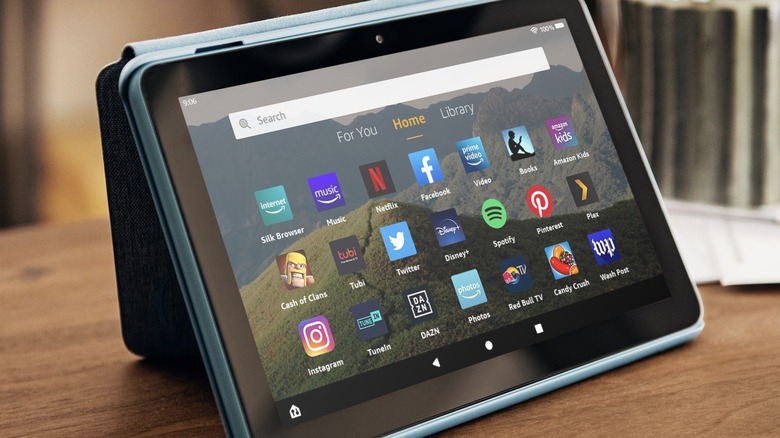Amazon's Big Fire OS Upgrade To Android 11 Will Bring New Features
Although it might come as a shock to many people, Amazon is one of the biggest Android tablet makers that doesn't make headlines or get included in charts. That's because the Fire OS platform it puts on its Fire tablets might not qualify as what many consider Android, but there's a true Android operating system underneath regardless — just not one that is certified by Google. That said, Amazon doesn't behave like a typical Android device manufacturer either, especially when it comes to keeping Fire OS in sync with the mainline Android Open Source Project (AOSP). That's why when Fire OS 8 for the upcoming Fire 7 (2022) tablet was revealed, there was a great deal of fuss over the update, especially among Amazon Fire device owners.
The Amazon Fire 7 (2022) on its own is already a significant upgrade over its 2019 predecessor because of the internal changes. Although the 7-inch screen and 2MP front and rear cameras remain the same, the processor has been bumped up to 2GHz from 1.3GHz, and RAM has been doubled to 2GB. Of course, these sound like dismal specs in comparison to other Android tablets, but the starting price of $60 earmarks it as a product for a completely different audience and purpose than other slates. The Fire tablet is and will always be a gateway to Amazon's services and content, and the inexpensive hardware is sufficient for accessing those platforms.
Amid its next-generation Fire 7 announcement, Amazon didn't dwell too much on the major Fire OS update that'll arrive with these tablets when they hit shelves in June — it will be Fire OS 8, the first major upgrade released by Amazon since Fire OS 7 was launched with the 2019 model. And just like the 2022 model of the tablet, it might seem like nothing has changed on the surface, but rest assured, there are some critical changes underneath.
New features in Fire OS 8
The most important upgrade that Fire OS 8 will bring is Android 11 from 2020. Fire OS 7 is still based on Android 9 Pie, which itself was launched back in 2018. By October, Android 11 will already be two years old, so it's not like Amazon is giving its customers the latest experience. This is still a significant upgrade, though, especially when it comes to improving the stability and security of the operating system. Of course, there are also some other features, many of them invisible to the end-user except for one particular change.
Fire OS 8 will finally support dark themes, one of the major features that Android 11 brought to the platform. It will also be able to support the HEIF image format, so users will be able to view photos that may have been taken on iPhones in that format. There are also plenty of changes when it comes to privacy features, like allowing users to grant one-time permissions to apps, letting apps access location in the background (with the proper permissions, of course), and more.
Amazon warns that not all Android 11 features will be present on Fire OS 8, including File Based Encryption, for example. End users might not even notice the changes that happened beneath the hood because Fire OS 8 will most likely look just like Fire OS 7. The bigger question mark, however, is when and if Amazon will roll out this same upgrade to other Fire devices, including Fire TV, something the company is a bit inconsistent with based on its history.

